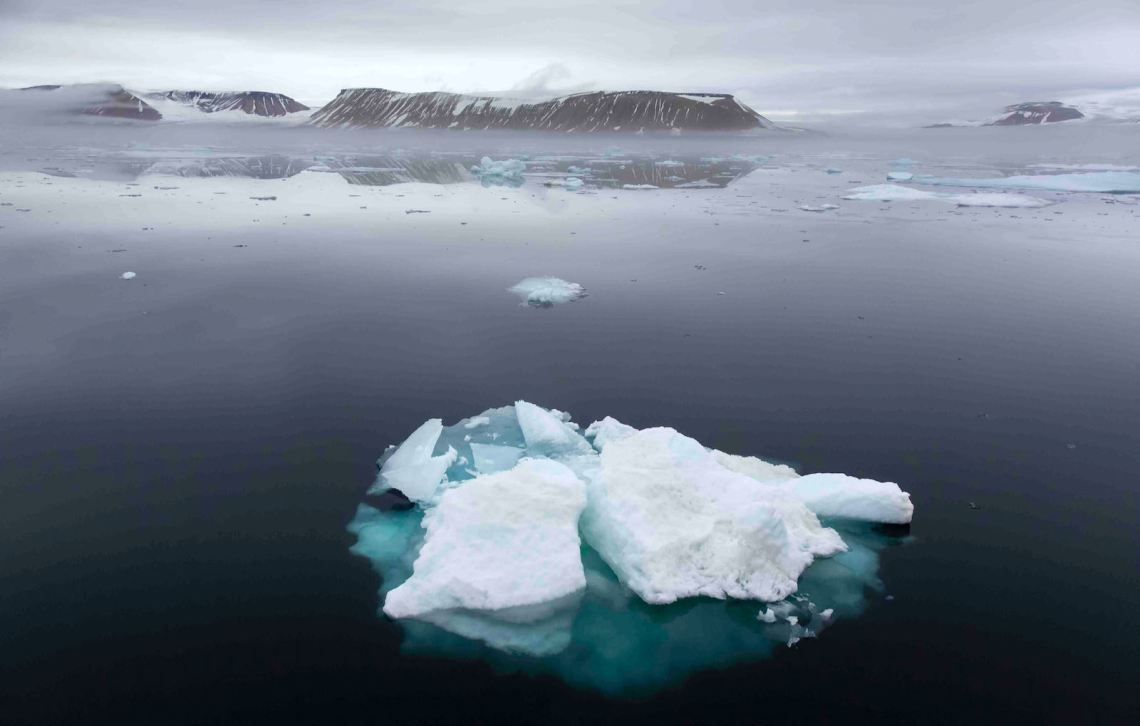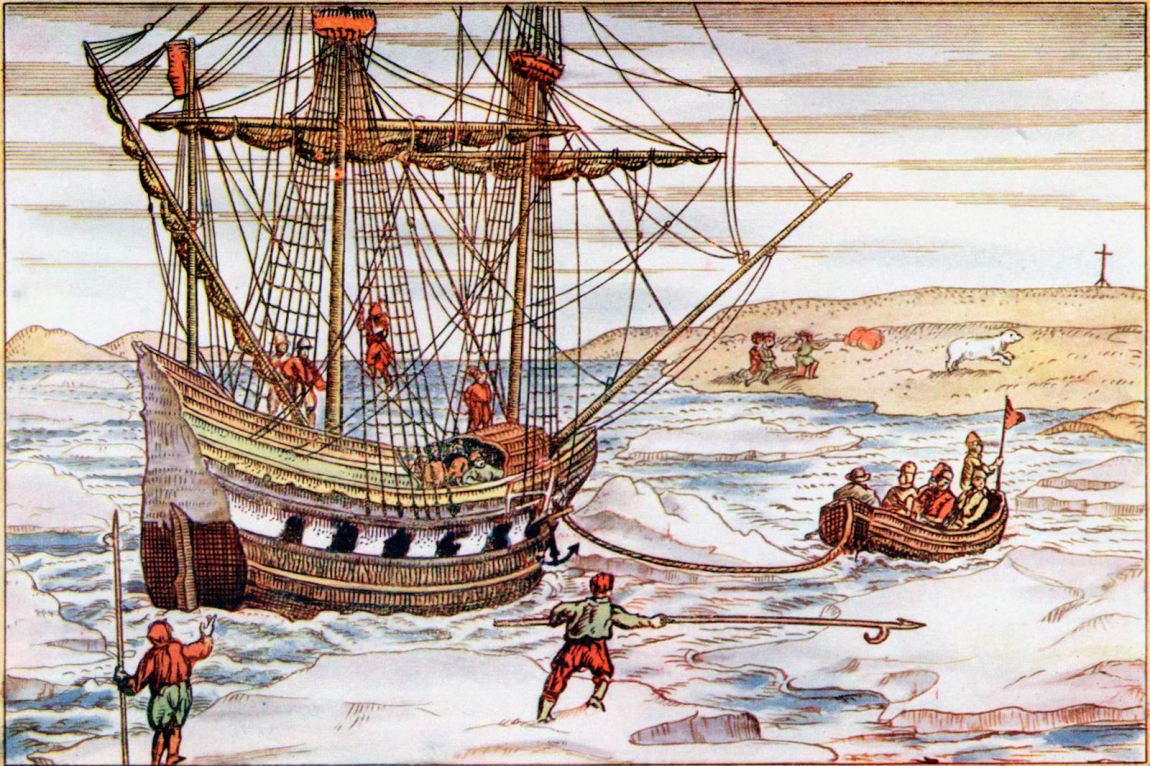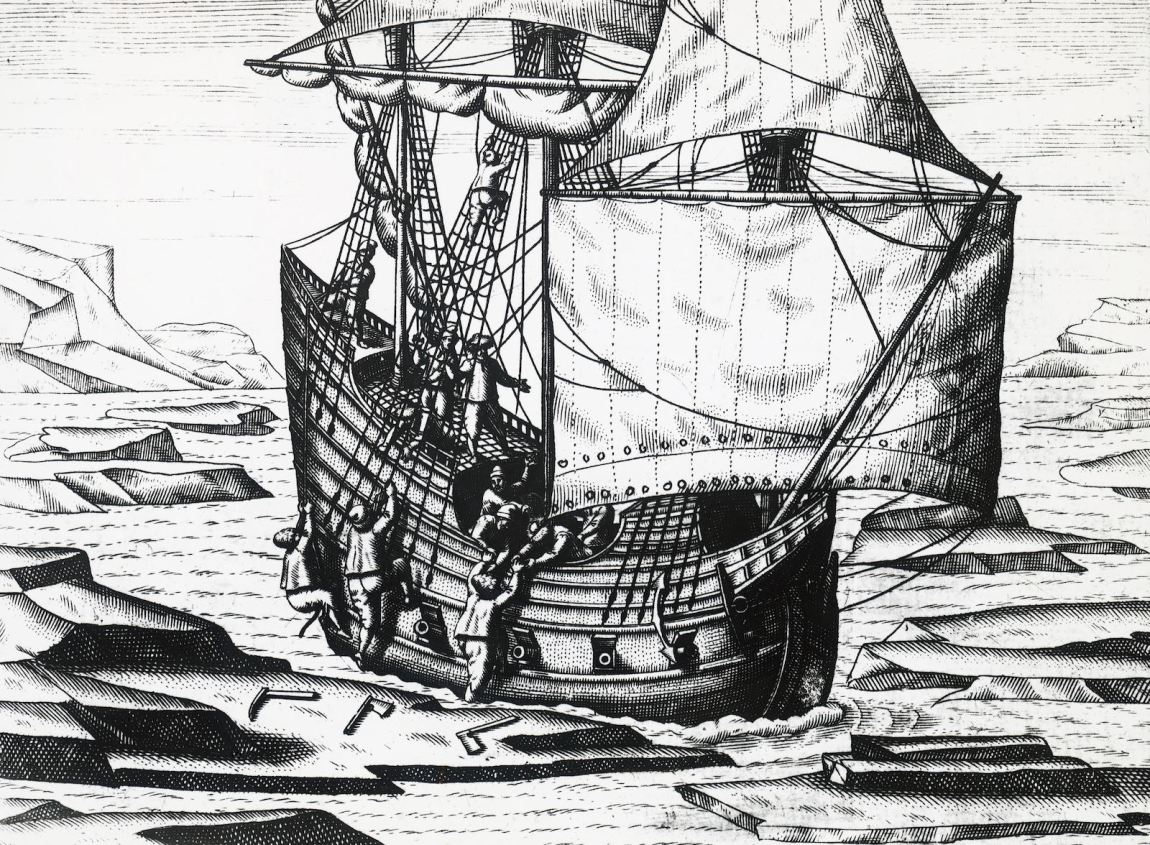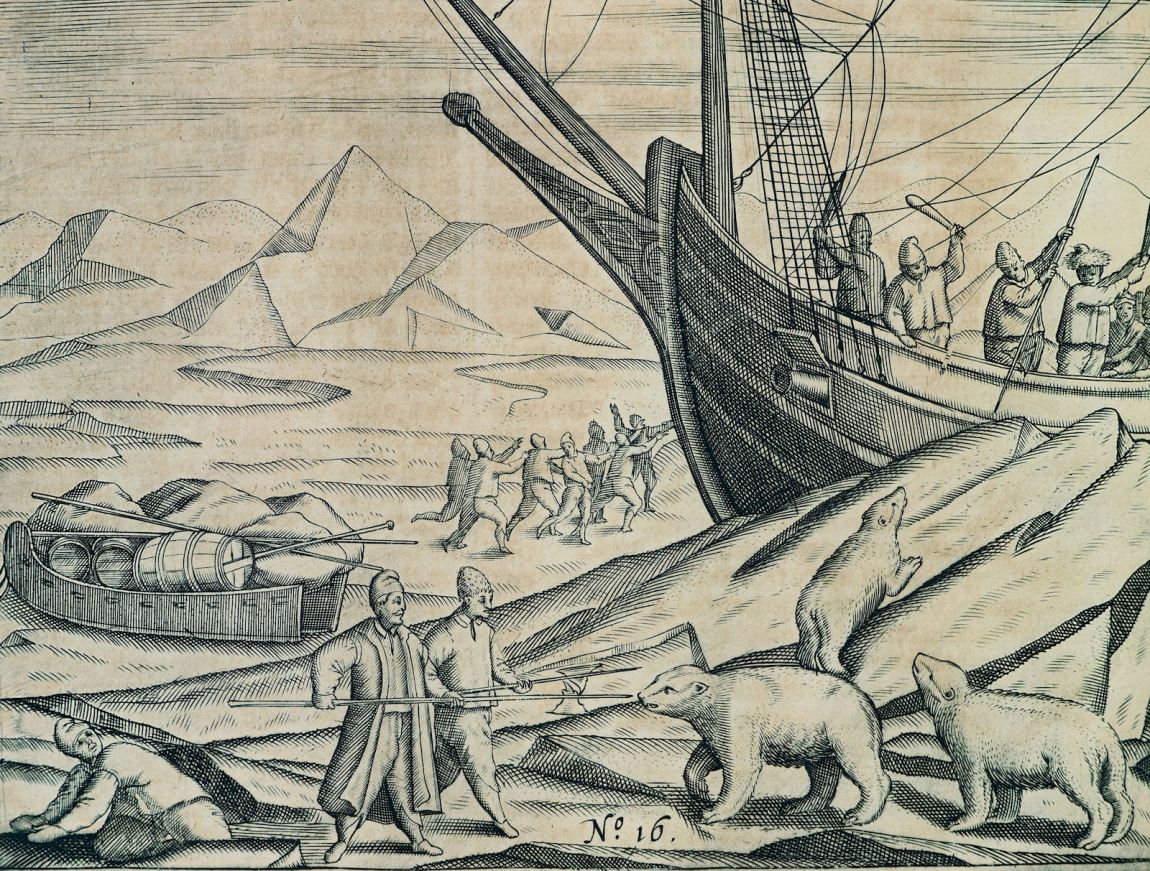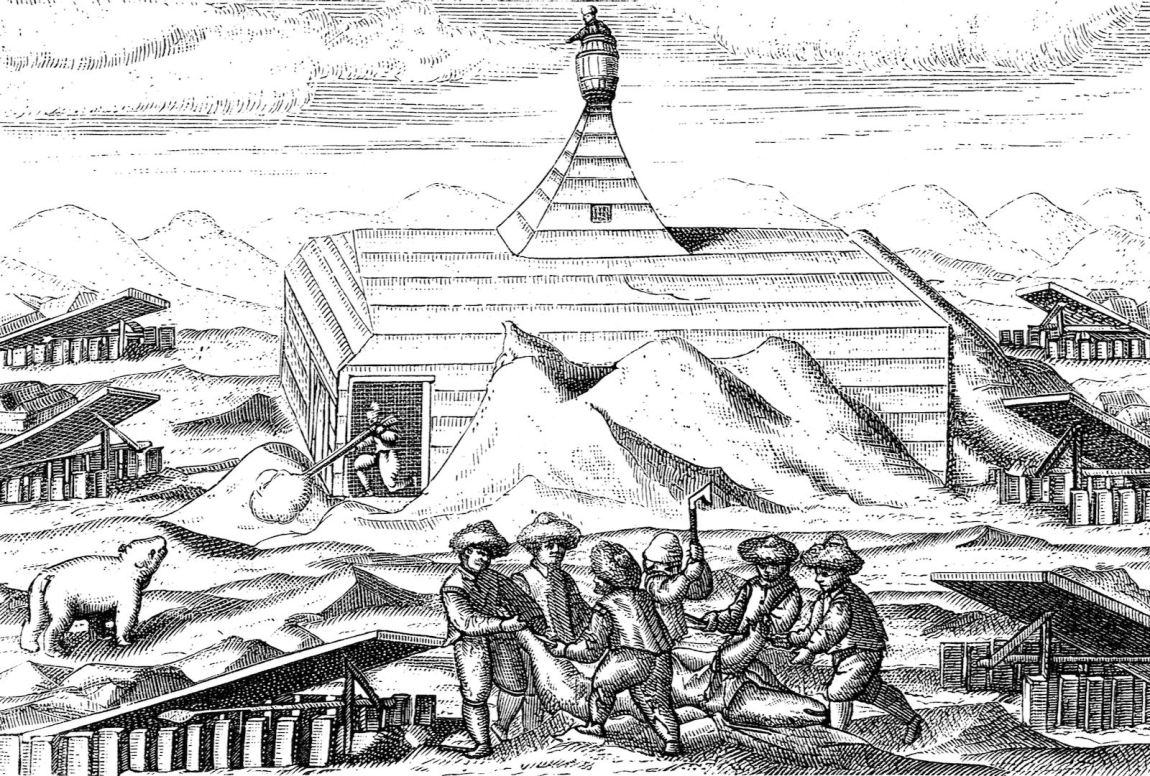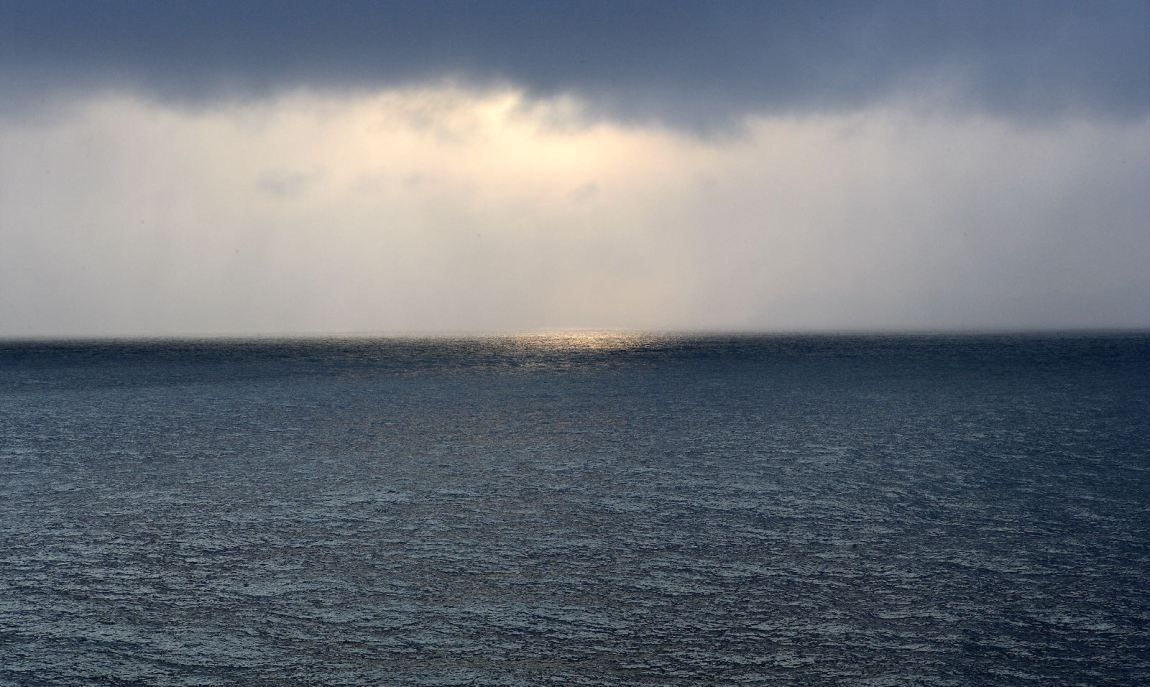In the end, the ship would be lost to ice. Three and a half months out of Amsterdam, with the crew already drifting into scurvy’s embrace, Dutch explorer William Barents found the passage east blocked. In the last days of August 1596, he surrendered to the Arctic for the third time.
Sent to find a polar trade route from Europe to China, Barents had managed to sail well north of Norway, mapping new terrain along the way. He had then traveled east with a crew of sixteen men, voyaging hundreds of miles above the Russian coastline, rounding the islands of Nova Zembla and making his way into a vast sea that seemed as if it might, with a little luck, carry him to his destination.
In 1594, on his inaugural Arctic expedition, he had seen his first polar bear. On his second trip a year later, he had seen men eaten by the bears. He had endured floating islands of ice that dwarfed his ship, and mutiny, and endless arguments with officers over their route. He had searched in vain for the ice-free polar sea that had been hypothesized since the days of ancient Greece—one that might offer a shortcut to the far side of the globe. After that open polar sea failed to appear early in his third voyage, he altered his route and instead set sail for the rising sun and a return to Nova Zembla—the farthest eastern point on his first Arctic expedition. He still hoped that it might serve as a waystation to the Far East.
But during the last weeks of summer, that hope, too, had failed him. As his ship sat off the northeastern coast of a desolate shore absent from every known map, the ice that had doomed Barents’s prior expeditions returned to haunt him. After trying in vain, day after day, to find an open path through the solid surface of the sea, Barents acceded to his crew’s entreaties to turn for home.
*
He had set out from the Netherlands on wooden ships in the last years of the sixteenth century and the first decades of a new Dutch republic. In that moment, William Barents stood far from immortality. If he pictured his future at all, he could hardly have imagined the daily price his exploration would exact from him during his remaining days on Earth, let alone the profound ways in which the collision of commerce and climate that shaped his destiny would go on to transform the globe he sailed after his death.
Soon after setting a course for home, Barents and his crew drew near Ice Harbor, one of the last places they had named along their voyage out. Through the end of August and into September, they kept trying to go first south and then north, but they found every return route blocked. The wind became a gale that knitted drift ice into new landscapes. Water hardened everywhere against them, and sailing became impossible.
Three men climbed overboard and began hacking at the pack ice with hand-axes and a pickaxe to free the ship. Suddenly, the vessel surged back into the current, nearly abandoning the sailors to their deaths. But the ice on which they stood was pulled in the same direction, and the crew made a leap for the ship. One man held on up front to the beakhead, a protruding platform for sailors working the bowsprit sails. Farther back, another caught hold of a cable strung through the corner of one of the sails. And a third grabbed the end of a line that ran from the mainsail down to the stern of the ship. All three were saved, but it became clear that none of them would be safe at sea for long.
That evening, the sailors again returned to Ice Harbor, and dropped anchor there. The weather turned fair, but it did not keep drift ice from closing in on the vessel again. The men lowered one of their small boats into the water and headed to land. The wind picked up, driving icebergs into the harbor toward the ship, their submerged portions slipping under the bow. Lifting the front end four feet into the air, ice began tipping the vessel astern.
The situation was no better a day later. The crew began to work at the solid sea with crowbars to break it apart. Making little headway, they commended themselves to the mercy of God. The current from the open water, which they could see but couldn’t reach, drove in more ice, grinding blocks into one another, packing the sheet even closer together and clamping the ship in a vise. Finally, a snowstorm set in, and under the pressure of the new ice and the wind chill, the ice began to crack and groan all around them.
Advertisement
By the time the storm was done and conditions had settled enough for the sailors to explore their plight, Barents saw that, again, the front end of the ship had been raised so that the bow sat several feet above where it would be when floating on open water. The stern of the ship hadn’t risen with it, but instead appeared to be stuck in a crevice of ice. But rather than isolating and protecting the tiller and the rudder, the crevice had somehow helped to shear off the steering mechanism, breaking it in pieces. Soon, more ice was driven into the harbor. The men brought out the small boats and stored them away from the ship, in case the main vessel sank.
The first days of September brought more of the same, as the ship was vaulted even higher by ice. A blizzard began, and crew members considered using a small boat to carry barrels of bread and wine ashore, where at least they wouldn’t have to worry about being crushed to death by icebergs or drowning in the frigid water. Mountains of ice hundreds of feet high pressed in toward them.
Barents and the crew waited three days in fear as the weather slowly improved, while the ice around them surged and subsided like the tide. After dinner on September 5, the ship began to list hard to one side. The hull held, but there was no way to right the vessel on the seething ice, more than two thousand miles from home.
The men had already witnessed the cataclysm of an iceberg detonating without warning in the water next to them. One such explosion in close proximity might create waves and flying debris that could sink a listing ship. After a meeting to confer on their options, they took their old foresail and used it to transport powder, guns, and some furniture ashore. Making a tent out of the sail and one of the boats, the sailors stockpiled bread and wine. They brought tools to mend another small boat that had been crushed, as it might become priceless if the ship itself were lost.
Crew members spent most of the following week shuttling between land and ship. Some men explored the terrain and found a source for fresh water, as well as wood that had washed ashore. Meanwhile, the wooden ice-knees, braces meant to protect the ship from collisions—finally gave way. The hull lay encased in more than three feet of ice. Two polar bears approached the men at night, but were scared off by a blast of the ship’s trumpet and a volley of gunfire.
On September 11, a party of eight well-armed men went ashore. They verified that there was still fresh water and found the driftwood the scouts had described. The ship lay pinned as it had for two weeks, with the fall equinox coming on. Twilight would soon give way to night, and behind it, winter. There was no relief in sight.
In spite of the spectacular efforts that had saved them in every crisis so far—sometimes flailing, sometimes inspired—nothing could draw the ship from the ice or carve a path through the frozen sea. The sailors assembled again and together acknowledged they could not rely on divine intervention to enable their escape. Amsterdam native Gerrit de Veer wrote in his journal that Barents’s men had resigned themselves to spending the winter on Nova Zembla “in great cold, poverty, misery, and griefe.”
*
Months of darkness followed, along with predators relentlessly threatening outside and disease slowly devouring the castaways from the inside. The story of Barents’s overwintering would become legendary, printed accounts of it making their way into five languages in the years following his death. Their saga even gained a nod from Shakespeare in the third act of Twelfth Night, in which a character is told he has sailed so far “into the north” of a lady’s cold opinion that he will “hang like an icicle on a Dutchman’s beard.”
And for good reason. Once ashore, the sailors built a cabin, in which they learned new modes of suffering. Even a timber shelter could not offer them any real haven from the taunts of snow, tempests, and the perpetual cold. Fall gave way to winter and endless polar night, with little hope that 1597 would begin more auspiciously than the old year had ended. They spent New Year’s Day trapped in the cabin. Offered their ration of wine, a small serving every other day, some of the men abstained, imagining how much hardship lay ahead and thinking it might be better to bank their luxuries against some future need.
Advertisement
Other than the moon, no light appeared except what they made by fire. Ice more than an inch thick formed on the inside of the cabin walls. The scurvy spreading through the crew would lend its hallmark stench to unwashed clothes and bodies, making the fetid atmosphere of the cabin even more oppressive. The most brutal weather kept them from going out, and feces piled up at the porch end of the shelter.
On January 2, they were reduced to using the last of the firewood they’d gathered earlier from the beach where driftwood accumulated, a long trek from their shelter. There was no question of hiking to forage for more in that moment; it wasn’t possible to be outside for any length of time and survive. Instead, they began to pry off nonessential parts of the doorframe. Next, they chopped up a wooden block on which they usually prepared their fish when it came out of the barrels.
Because a sailor’s destiny was tied to the weather and the wind, these, along with a ship’s location, were habitually the details that went into each day’s log, even when sailors were ashore. But conditions soon grew so bitter that they didn’t dare to open the doors for even the seconds it would take to determine the direction of the wind for the log. Instead, they hoisted a bit of scrap tied to one of their half-pikes, pushing it up through the chimney and watching to see which way it blew. Even that was tricky—they had to notice in which direction it rose as soon as the pike went aloft. Within seconds, the separate parts of the impromptu windsock froze into one solid staff.
It was fitting that they continued to record the wind direction day after day, because they might as well as have been at sea. Trapped in their cabin as if on board a ship battened down in a storm, their chimney made from a barrel in place of a crow’s nest, night crowded out day for them. But space and time had changed places: they no longer moved through the water, cresting wave after wave, trying to stay afloat; their shelter had become stationary. A whole sea of weather, though, was borne aloft and set in motion around them. Just as they’d gone in search of safe harbors on their voyage, the men now waited for any days of calm weather during which they could safely disembark from their cabin and hunt for provisions. As in unknown waters, they had little idea what might come next, or how they would survive long enough to find themselves warm and dry.
Aboard the ship, William Barents had set the course and kept to it, watching the sky and sea and interpreting them. The men trusted in his knowledge and accepted his vision for a route to China. Now they’d come as far as they could, but their dream of China was gone.
The ship’s strained timbers were leaking water, ice reigned supreme, and most of winter still lay ahead. Rather than crossing innumerable miles and unknown seas to find their way to the Far East, they were now forced to move entirely through the medium of time. If they lived to reach daylight’s return, they might attain the only goal left for them to pursue: a run for home.
*
Before Barents, other Europeans—Columbus, Magellan, and Vasco da Gama among them—had gained renown for their explorations, either because they helped to find new continents to plunder or a sea route around them. Their exploits had brought tangible assets to their patrons: gold, silver, or trade, and a stake in habitable new lands ripe for exploitation.
Barents, too, discovered new lands, but his history took a different form. After Barents, the northern polar regions were not simply a wished-for byway to the East in the European imagination, but also became a new frontier in and of themselves, a force to be reckoned with, an obstacle. Before Barents had ever set out, Pomor sailors in Russia and several Western expeditions had searched for a northern route between the Atlantic and Pacific Oceans. But by heading due north as far as he could sail at the beginning of his third expedition, Barents made what the nineteenth-century Dutch naval officer Koolemans Beynen called “the first true polar voyage.” The fact that Barents ended up overwintering on Nova Zembla, nowhere close to the Pole, simply became emblematic of his larger story: Barents’s failures derived from the immense adversity he faced, but in time, that adversity itself would become the source of his fame.
With his spell in the high Arctic and his overwintering, however inadvertent it had been, Barents would become the first face of the many polar explorers who followed in his wake. After Barents came Henry Hudson, who, just over a decade later, could not get even as far as Barents in his effort to sail northeast beyond Nova Zembla. After nearly three hundred years, the first attempts at expeditions to Barents’s cabin likewise failed to arrive.
Along with several attempts to reach Ice Harbor, the nineteenth century saw the resurrection of Barents’s story in the form of a melodramatic poem rooted in Dutch nationalism. Barents’s return to celebrity would also take place in the era in which the modern mythology of polar explorers crystallized. As technology delivered telegraph wires, newspapers, and later radio, each medium made it possible to track the progress of explorers heading farther and farther north, until they eventually flew over, landed on, and trudged to the North Pole itself.
Expeditions could still go awry in horrible ways; modern technologies and money were no guarantee of success. After the horrors of cannibalism on the 1845 Franklin expedition to discover a Northwest Passage in the Canadian Arctic, historian Beau Riffenburgh explains, the love affair with nature, and the romance of sailing into the unknown was supplanted by an imperative to subjugate nature by “filling in the blank spaces on the map.” The race to do so was spurred by circulation wars between newspapers promoting various explorers and expeditions dramatized stiff-upper-lip accounts in which audiences could agonize along with their heroes, almost in real time.
And much as the printed accounts of Barents’s three voyages had been a European best-seller in his day, books—paired with international lecture tours—became the chief vehicle by which explorers established a new culture of celebrity. Fridtjof Nansen, Robert Scott, Robert Peary, and Roald Amundsen all became public heroes—their physical prowess and fearlessness transforming them into demigods.
At the same time, a cult of suffering emerged as the nineteenth-century drew to a close. It is no wonder that Barents’s own reputation grew during this era: his ordeal could easily be bent to fit this new view of Arctic exploration as man’s heroic struggle against nature and his danger-filled efforts to dominate it.
*
In the end, William Barents failed to deliver on his Arctic mission in nearly every way. He’d lived through one near-mutiny and witnessed another full-fledged revolt, before the impossibility of sailing home ahead of winter on his third voyage made any threat of mutiny pointless. He never got to China. He didn’t find the open polar sea that had been the official vision behind his third voyage. They set out for Amsterdam the following summer on a return voyage as harrowing as their time on Nova Zembla. Only some of them made it home.
There was something larger than life in Barents living long enough to see all his epic plans fail. He’d staked the ship and his life on his pursuit of a northern route, and he’d lost everything. Barents would become less and less real over time as myth replaced man. The gaps left by his sparse biography create an emptiness that makes it possible to project or reflect whatever the viewer wants to see: he became the patron saint of devoted error, the pattern of the famous Arctic explorer who endured horrifying privations for a noble cause.
At the time of Barents’s death, the elusive Northeast Passage was still centuries away. Although the Netherlands didn’t immediately give up on the project, the Dutch would not be the first to find it. It might be tempting to imagine that by seeming to rule out the hope of an Arctic route to China, Barents and his men greatly delayed the opening of the Arctic. But soon after his last voyage, the high Arctic became a commercial focus for a very different reason. Within fifteen years, Western European nations would establish whaling four hundred miles above Norway along the coast of the island of Spitsbergen, wringing huge profits from northern waters and nearly wiping out the Greenland right whale.
After Barents, the high Arctic had not been conquered, but it had been infiltrated and would never close. In August of 2019, I sailed to the remains of his Arctic cabin myself. Standing on the shore not far from the log-strewn ruins, I put my bare fingers in the water to find that, where he had hoped to find a warm polar sea, it was still achingly cold. Even in high summer, when the wind stirred, this spit of land sticking out into the sea quickly became a numbing, desolate place. How much grimmer the view must have been during Barents’s months on Nova Zembla, when great blocks of ice pressed in on the shore.
The islands are now known by their Russian name, Novaya Zemlya, and the area home to Barents’s cabin has become a Russian Arctic preserve. It is still very isolated, though each year there’s talk of restarting a regular cruise to bring tourists to the ruins of Barents’s cabin and to abandoned research stations.
Dutch experts in shipbuilding and navigation came together in recent years to build a replica of Barents’s ship. Using relics of typical sailing ships of the day combined with the original illustrations published with the narrative of Barents’s voyages, a shipwreck expert named Gerald de Weerdt and a mechanical engineer, Koos Westra, have guided the hand-built construction of a vessel that replicates the original’s details that posterity has preserved and is now almost complete. The builders say they may try to sail it from the coast of the Netherlands all the way to the cabin at Ice Harbor, following in Barents’s wake. If they do, they hope to avoid the ice that blocked Barents’s way.
Even with the challenges of sailing a historical replica, the trip will be easier than it once was. Strangely enough, long after his demise, the dream of the passage to China has come true. Thanks to the climate change of the industrial age that reached every corner of the globe after Barents’s time, snow and ice surveys project that by 2040—perhaps much sooner—there will be no ice left at the North Pole in summer.
Already, by August 2017, the planet had changed so much that a Russian natural gas tanker equipped for Arctic voyages could travel for the first time without an icebreaker escort, sailing a northern route from Norway to South Korea in two thirds the time required for the traditional route through the Suez Canal. This stupendous change will be the end result of a process of exploration followed by exploitation that Barents and his Arctic expeditions foreshadowed. Though his crew returned with a dramatic tale of lands inhabited by polar bears and Arctic foxes, their ship still rode a tide of commercial expansion that would unleash destruction as powerful and enduring as any force in human history.
The open polar sea that Barents had forecast will soon exist every year during the hottest months. He just sailed four hundred years too soon.


